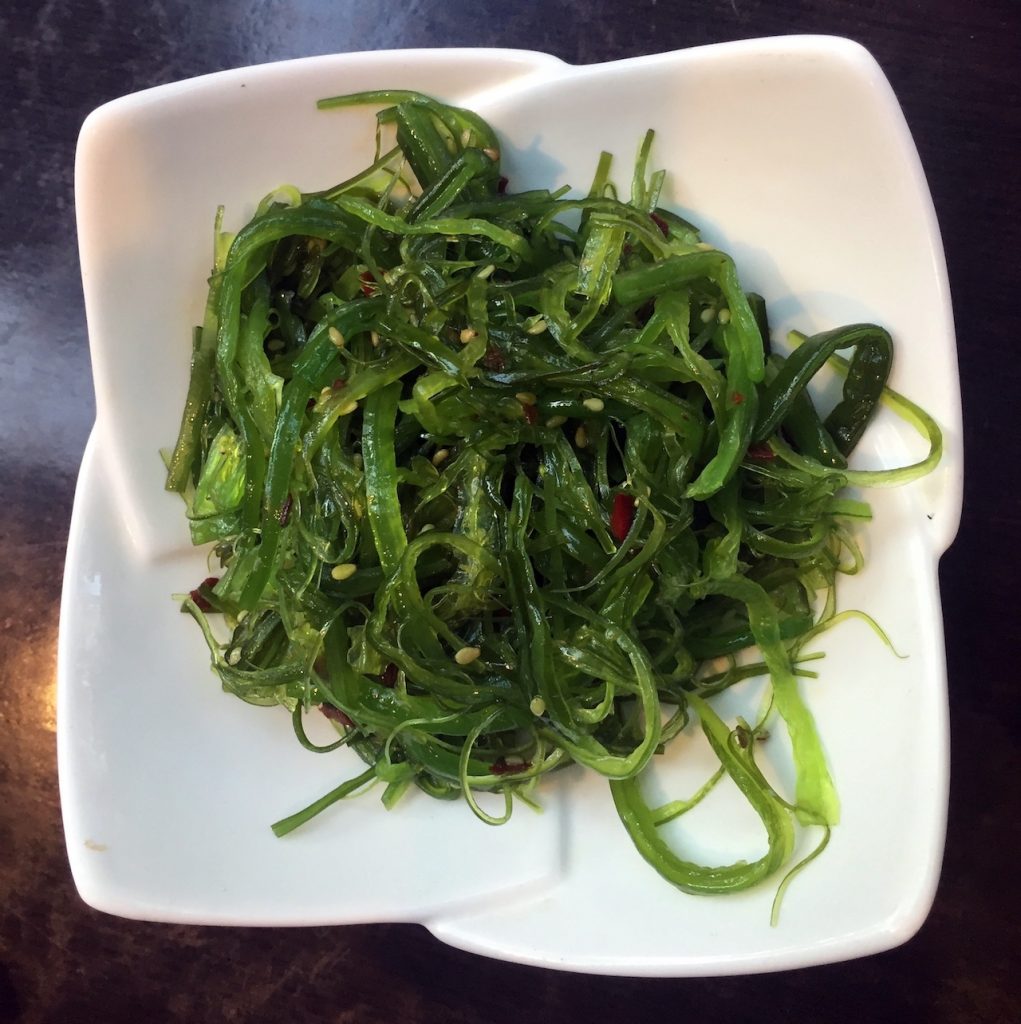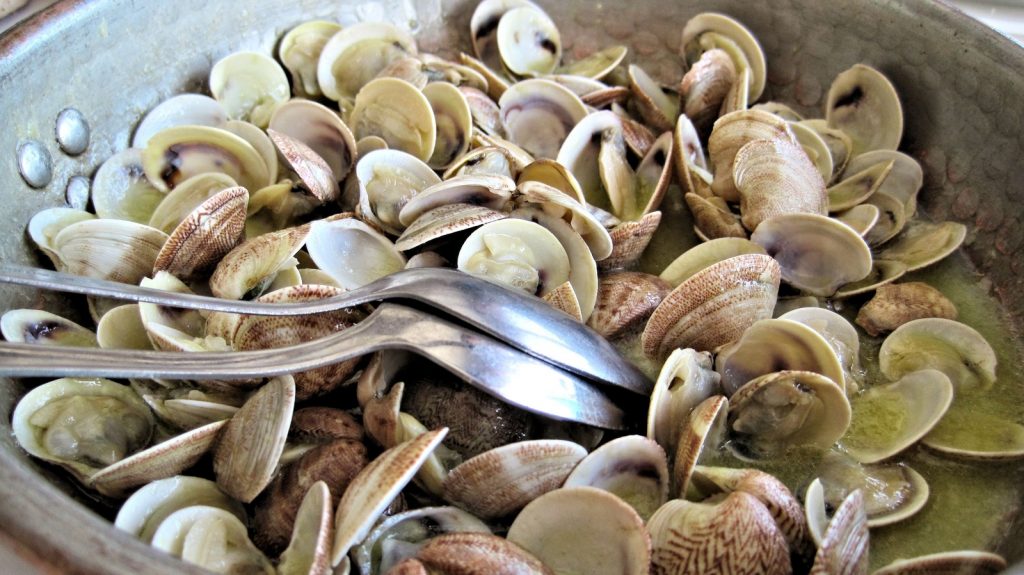[Article updated on 19/09/2023]
Seaweed has long been a staple food of Japan, one of the oldest living crops in the world. A brown or dark green colored seaweed, which is commonly used in Japanese cuisine, wakame has a salty, briny taste with a slight sweetness. Typically, this seaweed is used for recipes like miso soup or seaweed salad. Like many seaweeds, wakame adds a delicious flavor to a variety of dishes, but recently it has gained popularity due to its many health benefits. Wakame is rich in a number of vitamins and minerals. It provides a big nutritional boost while supporting the cardiovascular system, maintaining hormonal balance, strengthening bones, improving circulation and promoting skin health.
Composition
Wakame comes from the cold waters off the coasts of Japan, China and Korea. It is rich in vitamins and minerals, such as folate, vitamin B2 and manganese. It has been used for centuries for its therapeutic and healing benefits, with the power to support cardiovascular health, boost energy levels and provide the body with omega-3 fatty acids.
100 grams of raw wakame contains approximately 45 Calories, 1 gram of fat, 9 grams of carbohydrates, 1 gram of sugar and 3 grams of protein. It contains 196 micrograms of folate, 0.2 milligrams of vitamin B2, 1.6 milligrams of vitamin B3, 360 international units of vitamin A, 5.3 micrograms of vitamin K and 0.7 milligrams of vitamin B5. Wakame also contains 3 milligrams of vitamin C, 1 milligram of vitamin E and 0.1 milligrams of vitamin B1 per 100 grams.
The plant is very rich in mineral salts. One hundred grams of this algae contains 1.4 milligrams of manganese, 872 milligrams of sodium, 107 milligrams of magnesium, 150 milligrams of calcium and 0.3 milligrams of copper. There are also 2.2 milligrams of iron, 80 milligrams of phosphorus and 0.4 milligrams of zinc.
Here are the 17 unsuspected virtues of Wakamé.

The virtues of wakame
#1 A beneficial effect on digestion
Wakame is a healthy source of fiber, essential for maintaining digestive function. Fiber allows the body to defecate regularly and prevents diseases such as diarrhea. Wakame helps keep the gastrointestinal tract free of disease. Regular bowel movement ensures that the body is able to absorb nutrients efficiently and break down complex fats and carbohydrates in food more easily. Wakame is low in sodium and has diuretic properties, and targets excess water retention in the body. This water retention is the main cause of bloating.
#2 Balancing Hormones
Wakame provides manganese, iron and calcium, three minerals that help balance hormones naturally. Manganese and calcium help improve PMS symptoms. In fact, a study published in theAmerican Journal of Obstetrics and Gynecology found that women who have lower levels of manganese in their blood experienced more pain and mood-related symptoms during PMS and menstruation. Because manganese helps regulate hormones and exhibits antioxidant activity, wakame may also work as a natural infertility treatment.
#3 Improved fat burning
A Japanese study conducted at Hokkaido University suggests that fucoxanthin found in wakame promotes fat burning in fat cells. According to the study, fucoxanthin fights fat in two ways: It promotes the action of proteins that cause fat oxidation and is found in the type of fat that surrounds organs. Fucoxanthin also promotes the production of DHA in the liver, which helps lower bad or LDL cholesterol. Fucoxanthin also reduced the weight of abdominal white adipose tissue in rodents, making it one of the best foods for burn fat.
#4 Improved cognitive abilities
Wakame is very nutrient dense. Vitamins, minerals and good fatty acids not only promote healthy bodily functions, but are also very effective in maintaining brain health. Studies suggest that people with regular intake of wakame have higher alertness and brain activity than those who do not consume it. People who eat wakame are able to maintain healthy memory and brain function into old age without being affected by memory loss.

#5 Bone Strengthening
One hundred grams of wakame provides 15% of the daily calcium requirement, which is essential for preventing osteopenia or osteoporosis. Foods rich in calcium help increase bone growth and speed up bone repair. Calcium deficiency occurs easily, as this mineral is excreted through the intestines, kidneys and skin.
Osteoporosis is a common feature of aging. It is a loss of bone tissue that begins in women at the time of menopause and in men around the age of 55. This can lead to increased fracture rates, which is why it’s so important to get enough calcium in your diet.
#6 A beneficial plant for pregnancy
Folic acid, or vitamin B9, is an essential vitamin found in wakame. It is needed to copy and synthesize DNA, produce new cells, and support nerve and immune function. Folic acid is known to be one of the most critical vitamins for a healthy and vibrant pregnancy.
For pregnant women, folic acid deficiency is particularly risky, as it can lead to neural tube defects such as spina bifida, anencephaly, limb malformations and heart complications. Because folic acid is necessary for copying DNA and building new cells, it is essential that pregnant women eat enough foods rich in this vitamin, such as wakame, to reduce the risk of kidney problems. development in the baby.
#7 Reduction of high blood pressure
Several studies have examined whether wakame has the ability to naturally prevent high blood pressure. Such a study, published by theAnnals of Nutrition and Metabolism, showed that wakame treatment significantly reduced the systolic blood pressure of spontaneously hypertensive rats. Another study carried out in Japan confirmed that dietary wakame could have beneficial effects on hypertension.
An interesting study on the subject was conducted in 2011 and looked at whether seaweed could affect blood pressure in children. Healthy Japanese preschoolers, aged 3 to 6, had their blood pressure and pulse measured before and after a three-day period in which they took seaweed. Blood pressure measurement, complete dietary records, and parent-reported height and weight were obtained for 223 boys and 194 girls.
Researchers found that girls with higher seaweed consumption had significantly lower systolic blood pressure readings. The results suggest that seaweed consumption was negatively related to diastolic blood pressure in boys and systolic blood pressure in girls, showing that seaweed may have beneficial effects on blood pressure in children.
#8 Reduction in cholesterol levels
The fucoxanthin found in wakame serves another purpose: it stimulates the liver to produce DHA, helping to reduce the amount of harmful cholesterol in the body. Therefore, it is an excellent cholesterol-lowering food.
A study published in the Journal of Nutrition revealed that dried wakame powder altered the activities of enzymes involved in fatty acid metabolism in the liver of rats. Rats that were fed diets containing wakame powder had lower triacylglycerol levels, suggesting that wakame is useful as a food to prevent hyperlipidemia. Hyperlipidemia means there are too many lipids or fats in the blood. This leads to high cholesterol and triglycerides, which can lead to the development of fatty deposits in the arteries and dangerous blockages.
#9 A beneficial plant for the heart
Wakame is known to help with cholesterol and heart problems. It inhibits the production and accumulation of fats. It also stimulates the liver to produce more DHA, which is actually a good way to lower the amount of cholesterol in the body. Bad cholesterol is responsible for heart disease and blocked arteries. So, ingesting this seaweed can help prevent various types of heart diseases, like attacks and strokes. Due to its high iron content, wakame is ideal for increasing circulation. The increased circulation of high iron helps boost energy, improve the health of your skin and also speed up the body’s healing process.
#10 A good source of iron
The iron in wakame increases the production of red blood cells and aids the enzymatic metabolic processes that the body carries out to digest proteins and absorb nutrients from food. Iron deficiency is the most common nutritional deficiency worldwide and is associated with developmental delay, impaired behavior, reduced intellectual performance, and reduced resistance to infections. Excessive iron supplementation, however, can cause iron overload and should be avoided, so the safest and purest way to get enough iron daily is to stick to iron-rich foods like the wakame.

#11 A food rich in omega-3 fatty acids
Wakame is a good source of omega-3, which is an essential fatty acid that cannot be manufactured by the human body, but is necessary for normal metabolism. Omega-3s can be used to lower cholesterol, fight depression, reduce anxiety, reverse diabetes, reduce inflammation, relieve arthritis, and promote skin health. Studies have shown their ability to support weight loss, promote pregnancy, boost athletic recovery, and promote thickening of hair and nails. Due to the excessive consumption of omega-6 fatty acids in the Western world, it is important to incorporate omega-3 fatty acids that the body needs into your diet.
#12 Anti-aging property
Aging is a natural process and cannot be stopped completely. However, it is possible to slow it down significantly. Wakame is an excellent source of antioxidants, particularly vitamin C, which is an ingredient the body uses to create collagen, which keeps skin healthy and elastic and reduces the effects of free radicals.
#13 Anemia Treatment
There is a misconception that plants are relatively weak sources of iron and copper. Wakame is a marine vegetable that provides 0.028 mg of copper and 0.28 mg of iron per serving of just 10 grams. This makes the herb exceptionally good for people who suffer from iron deficiency and where conventional medicine has come a long way in treating this deficiency. Taking iron injections can be painful and is not suitable for everyone. Wakame, on the contrary, has an exquisite taste. It can be added to salads, soups and side dishes to increase its copper and iron intake. This helps counter diseases such as anemia and is safe for maintaining optimal energy levels.
#14 Wakamé: an algae with anti-inflammatory effects
Wakame has been shown to have anti-inflammatory properties and may also reduce heartburn. Most health problems are the result of inflammation in the body and wakame helps calm inflammation on the skin, in the joints and is also used to treat fever. This helps prevent osteoporosis, arthritis and joint pain.

#15 Wakamé, an algae that stimulates immune function
The first studies on wakame and immune function were conducted in vitro, meaning in the laboratory, rather than in human subjects. According to Dr. Michael Greger, author of the best-selling How Not to Die, these studies showed that wakame can quadruple the replication potential of T lymphocytes, which are an important part of the immune defense.
Such positive results led to subsequent testing of wakame’s effects in real people. In one study, researchers gave 15 people with various herpes infections, ranging from oral herpes to chickenpox, about two grams per day of pure powdered wakame (or about a quarter cup of seaweed salad). . The results were impressive: for each subject, symptoms improved or even disappeared.
#16 Diabetes Reversal
An important component of wakame, fucoxanthin, exerts an antidiabetic effect. A 2009 study in Japan examined the anti-obesity and anti-diabetic effects of wakame lipids rich in fucoxanthin on obese mice. When wakame was added to the high-fat diet, it significantly decreased body weight.
Before wakame treatment, mice showed signs of hyperglycemia, hyperinsulinemia, and hyperleptinemia, but the addition of wakame to the diet normalized these conditions. Researchers concluded that wakame has the ability to prevent diabetes, related disorders and obesity by reversing insulin resistance that is caused by a high-fat diet.
#17 Reduced risk of breast cancer
There is a small amount of research that suggests there is a relationship between seaweed and a decreased risk of breast cancer. In traditional Chinese and Japanese medicine, seaweed is used to treat tumors. People who regularly eat seaweed, especially in Japan, have significantly lower rates of breast cancer. In 2013, researchers at the University of California evaluated the impact of introducing wakame into the diets of American postmenopausal women. Fifteen healthy postmenopausal women were recruited for the three-month clinical trial. Five of the women had no history of breast cancer (they served as a control group) and 10 were breast cancer survivors.
Consumption of seaweed lowered the concentrations of urokinase-type plasminogen activator receptors (uPAR), a protein present in several physiological locations and whose concentration is generally higher in postmenopausal women. The concentration of uPAR is known to influence cell surface signaling, adhesion calling and growth factor communication, as well as responsiveness in breast tissue. Researchers believe that wakame’s ability to lower these receptors could help explain the lower incidence of breast cancer and mortality among postmenopausal women in Japan.
Another interesting study published in 2004 suggests that fucoxanthin found in wakame may act as a compound chemopreventive and chemotherapeutics in colon cancer cells. There is no doubt that science supports these incredible benefits of wakame and more studies are underway to evaluate its effectiveness as a cancer treatment or preventative measure.

Potential side effects of wakame
Although wakame is a nutritious food that offers a good handful of health benefits, it contains a fair amount of sodium (872 milligrams per 1 ounce of wakame). People with hypertension should therefore monitor their wakame intake to ensure that they do not consume too much sodium in one day, as sodium works against potassium to increase blood pressure.
How to use and cook wakame?
We find wakame dried or fresh. It can be stored in a refrigerator or with sea salt. It is also found in sealed packaging where it is dehydrated and brittle, similar to nori (the seaweed used to roll sushi). If you have dehydrated wakame, you will start by cutting it into small pieces, because it will expand after being rehydrated. To rehydrate purchased wakame, you will need to soak it in water for about 30 minutes or until it is soft. It can then be added to soups, fries and salads. The water used to rehydrate wakame is also nutrient-rich, so it can be used as a base for soup. Wakame is a versatile seaweed that can be added to so many recipes.
Purchased wakame can be added to a stir-fry with soba noodles, fish, mushrooms, daikon and other vegetables. You can also rehydrate wakame and add sesame seeds, chili powder, ginger and sugar to create a simple and delicious Japanese recipe. It is also possible to mix wakame, with cucumbers, sesame oil, rice wine vinegar and sesame seeds to make a wakame salad. You can also combine buckwheat noodles, wakame, shrimp and avocado for a filling and nutritious meal. You can rehydrate the wakame and add water miso paste, small cubes of tofu, dashi, shredded cabbage and carrots. You can also roll wakame salad and daikon spouts in nori sheets to make wakame sushi.

Wakamé is a pure marvel of nature! From wakame paste to seaweed tea, this marine treasure is a source of nutrients in all forms, rich in protein and calcium, with many anti-inflammatory and healing properties. Wakame is used in oriental medicine to detoxify the blood, relieve digestive distress and improve reproductive health. It has been shown to reduce the size of tumors and goiters. Wakamé has also been touted for its anti-aging properties and its ability to energize and rehydrate skin and hair.
